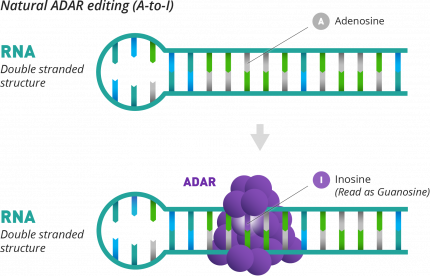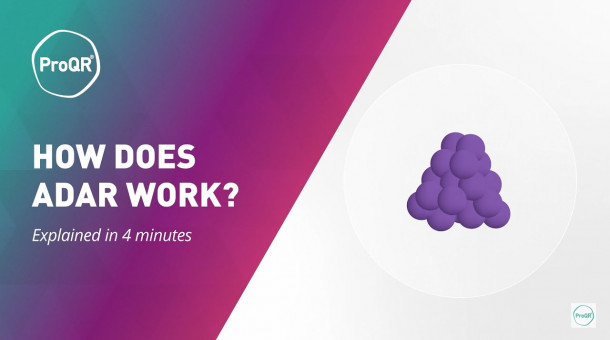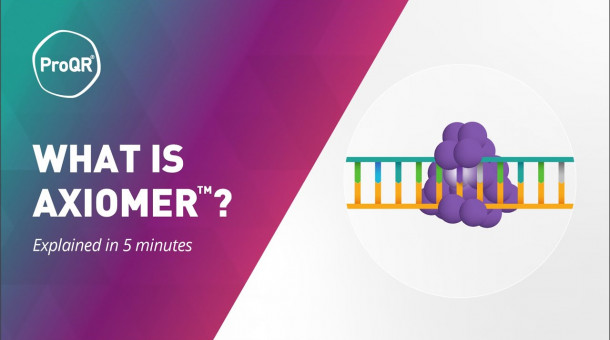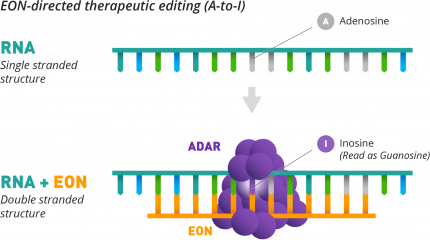What is RNA and how can we use ADAR, the body's own RNA editing machinery to treat disease? On this page we explain the Axiomer™ RNA editing technology and how we are creating a new class of medicines.
What is RNA
RNA stands for ribonucleic acid and it is an essential component of all living cells. It is best known for its use during ‘translation’, the process in which the information in RNA is used as a blueprint for the production of a specific protein. RNAs themselves are produced in a process called ‘transcription’, where the genetic code in DNA is copied into RNA. The RNA code is composed of nucleotides, which are marked by specific letters: adenosine (A), guanosine (G), cytidine (C), and uridine (U).

What is RNA editing
RNA editing describes the natural, continuous, molecular process in which the information content of RNAs is altered after transcription. RNA editing is essential for cells to create different variants of proteins that are produced from single genes. It can also regulate the function of the RNA and helps protect against unnecessary immune reactions.
What is ADAR
There are different ways in which RNA is edited in a cell. One of the most common is A-to-I editing, where an A nucleotide (adenosine) is changed into an I nucleotide (inosine). A-to-I editing is performed by an enzyme called Adenosine Deaminase Acting on RNA, or ADAR. It normally binds to double stranded structures in your RNA where it then edits the specific adenosine.

Watch: How does ADAR work?
In this video we explain in 4 minutes how we can use ADAR, the body's own machinery to treat diseases.

What is Axiomer
ProQR’s proprietary Axiomer™ technology is based on short strands of synthetic RNA, which we call editing oligonucleotides, or EONs. EONs are designed to specifically bind to the target (single stranded) RNA and mimic the double stranded structure that normally attracts ADAR.
An EON can attract ADAR to a specific location in an RNA to make an A-to-I edit. We can use this technology to correct an RNA with a disease-causing mutation back to a normal RNA or change a protein so that it will have a new function that helps prevent or treat disease.
Watch: What is Axiomer?
In this video we explain in 5 minutes how Axiomer™ and our EONs work.


Through this process, our Axiomer™ technology makes it possible to treat diseases in a new way by enabling your own body to treat the disease. Since the EON is a short piece of modified RNA and the cell’s own editing enzyme is used, no proteins need to be introduced that would not normally be present in our cells. This makes the manufacturing and delivery of the medicine much easier compared to other technologies, such as gene therapy and gene editing.
Additionally, editing the RNA instead of DNA makes the change transient with less risks of permanent side effects. With the possibility to change the function of a protein by A-to-I editing, there are a vast number of disease-causing mutations that could potentially be corrected using the Axiomer™ technology.

How does Axiomer work
The Axiomer™ technology has the potential to be a widely applicable technology, which could enable the development of a completely new class of medicines for conditions that currently have no treatment. By altering the protein through these steps, we can alter the course of disease:
- First, we identify where an A-to-I edit could change the course of a specific disease. We then design an EON to specifically bind to the target RNA and mimic the structure that normally attracts ADAR, so that the EON enables the desired edit.
- The EON is periodically delivered to the tissue or organ that is affected by the disease.
- Once the EON enters a cell it binds to the target RNA. The EON and target RNA combination attracts the ADAR enzyme where it edits the specific ‘A’ to an ‘I’ in the target RNA.
- During translation the ‘I’ in the target RNA is read by the cell as a ‘G’, resulting in the production of the corrected or altered protein.

Presentations & Publications
Have a look at our selected Axiomer presentations and publications for a deep dive into our research.
Internal link See the science